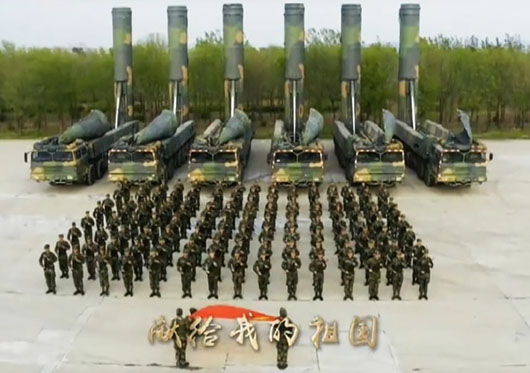by WorldTribune Staff, March 13, 2024
Only days before Joe Biden said his team was cutting military spending, U.S. Strategic Command Commander Gen. Anthony Cotton told the Senate Armed Services Committee that China’s People’s Liberation Army (PLA) likely has achieved superiority over the U.S. in theater nuclear weapons and is now developing its next generation intercontinental ballistic missile (ICBM).
Overlooked by media focus on other conflicts, this astounding development and the administration’s lackadaisical approach to national security prompted a Wall Street Journal editorial to conclude: “The political class in Washington is failing at its most important obligation, which is providing for the nation’s defense.”

In his Feb. 29 testimony, Gen. Cottons said “the PRC likely has more than 500 operational nuclear warheads and,… could have more than 1,000 nuclear warheads by 2030.”
Cotton added: “The PRC has approximately 1,000 medium and intermediate-range dual-capable conventional or nuclear ballistic missiles capable of inflicting significant damage to U.S., Allied, or partner forces and homelands in the Indo-Pacific.”
He also said that China “is developing a new generation of mobile ICBMs.”
Reporting for Geostrategy-Direct.com on March 12, Richard Fisher noted that Cotton’s testimony represented “the first ever revelation by a U.S. government official that the PLA could have up to 1,000 dual-capable medium and intermediate, or theater range ballistic missiles, meaning that the PLA could have up to 1,000 nuclear armed theater range missiles.”
In all issues of the Pentagon’s China Military Power Reports since 1999 there has been no revelation of the number or potential number of theater nuclear weapons possessed by the PLA.
“This points to a profound vulnerability for the United States and the credibility of its ability to defend its Asian allies by deterring Chinese nuclear coercion and nuclear attack,” Fisher wrote. “The U.S. today has no tactical nuclear bombs or nuclear armed medium range or intermediate range ballistic missiles or nuclear armed cruse missile based in Asia.”
A growing and combined Chinese and Russian strategic nuclear force, Fisher continued, “could deter/neutralize U.S. strategic nuclear forces, making it safer for China and Russia to exercise theater nuclear coercion or actual strikes.”
In a second March 12 report for Geostrategy-Direct.com, Fisher noted that China’s “official” military budget will grow by 7.2 percent according to Chinese Ministry of Finance reports submitted to the National People’s Congress (NPC) of the Chinese Communist Party on March 5.
This would result in an estimated military spending budget for 2024 of $236 billion or close to 40 percent of China’s central government expenditure.
China goes to great lengths to conceal its real military spending, in that its military budget figures do not include the many contributions made by other budgets, meaning actual annual Chinese military spending is much higher.
In September 2023, U.S. Senator Dan Sullivan, who is on the Senate Armed Services Committee, revealed estimates that China’s actual military spending is closer to $700 billion, quite close to that of the United States.
The Wall Street Journal Editorial Board noted China’s increase in defense spending in a March 12 editorial slamming Biden’s cuts in military spending.
“President Biden opened his State of the Union address last week invoking Franklin D. Roosevelt in 1941. This week he rolled out a military budget fit for 1991, the twilight of the Cold War. Will Congress step up to defend the country amid compounding threats?” the editorial stated.
“Congress will have to deal with the budget deficiencies, perhaps in a supplemental bill later this year. Yet Congress has been mired in so much dysfunction that both chambers haven’t been able to pass an appropriation even for fiscal 2024 for the Pentagon. The political class in Washington is failing at its most important obligation, which is providing for the nation’s defense,” the editorial said.
The Journal noted that the Biden Team’s military budget axe targets included:
• The U.S. Navy will purchase only six ships and retire 10 early, which would shrink the fleet to 287 ships in 2025 from 296 today. Perhaps the most egregious choice is the Administration’s decision to purchase only one Virginia-class attack submarine, instead of a planned two.
• U.S. submarine technology is a crown jewel of American military power and a true advantage over a rapidly expanding Chinese naval fleet. The industrial base is struggling to produce two boats a year, and the Administration presents its decision as a concession to this incapacity.
“Yet buying only one boat is a terrible signal for capital investment, and it tells adversaries that the U.S. isn’t serious about rearming,” the editorial said.
“Remember the news only weeks ago that Russia is fielding anti-satellite weapons that threaten the U.S. homeland? The U.S. needs to diversify and harden its satellites in space, yet the Biden budget would cut the Space Force by $600 million over last year’s request. That is 2% of the force’s budget, even as the services will have to finance a proposed 4.5% pay increase for troops.”
The editorial continued: “Interest on the national debt will cost more than the U.S. spends on defense this year, and the gap will continue to widen. The federal government gives more cash to state and local governments (e.g., Medicaid money) than it spends on its own defense. These are the priorities of a peacetime welfare state, not a nation serious about defending itself in a world of determined enemies and new technology that will put the U.S. at increasing risk.”
